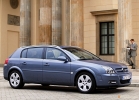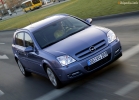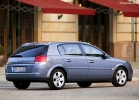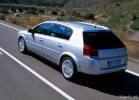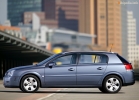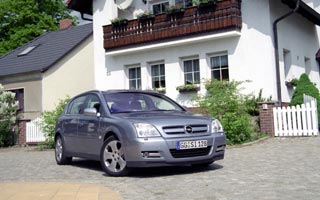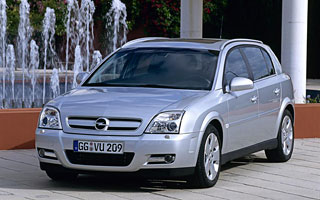West drive Opel Signum 2003 - 2005 hatchback
Opel Signum Progress child
Opel Signum is different from all other cars, first of all, its unusual positioning. In order not to waste time on endless explanations about the unusualness of this model, marketers of a German company simply called it a representative of the new Signum class! That is, the fact of his appearance Zignum founded a new, hitherto unknown class of cars, the only representative of which he himself is. There is nothing unusual in this: it has already happened. Renault Scenic, Toyota Rav4, Subaru Outback, Renault Espace - all these models at different times became the ancestors of new classes or at least subclasses. So Zignum has every chance to go down in history precisely as a model of a new class. Now it is very fashionable ...Vectra is turning ...
In order not to get confused in technical terms and not load you with many numbers and examples, we will talk about Zignum as simple as possible, without trying to in no way attach it to the existing system of classification of cars.
If you call everything with its names, then Opel Signum is the same vector, only with an elongated wheelbase, an interesting and unusual body shape and the original rear of the cabin. Everything else - motors, pendants, transmission, front -line body panels and front doors of both models are completely identical, up to the indexation of spare parts. And the fact that in the end the car was presented in the form of an unusual hatchback, and not in the form of a long -ostan station wagon (good idea!), This is just another whim of marketers - they decided that only in this form Opel Signum would be the most interesting to consumers.
A kind of such a team of a hodgepodge was already offered to customers. It was a Skoda Superb, which was a slightly modified VW Passat B5, also with an elongated base. But only in that case, the Czechs decided not to particularly experiment with the shape of the body - Superb remained a sedan, like his donor. And Opel, when he designed Zignum, still decided to take a chance - to try to sell not just an unusual car, but also with an unusual body type.
True, the comparison with Skoda in this case is not entirely appropriate, because Superb was, in fact, an ordinary stretch - an elongated limousine with an insert in the central part of the body. Moreover, the Czechs did not even have to develop anything - for the Chinese market, where most cars were service, such a long -playing passat was produced, which became the basis for the new Skoda. The car was only slightly changed in appearance so that it looked like the rest of the models produced under this brand. In all other respects, she remained a passato: a platform, engines, absolutely all body elements and even an interior.
In the case of Zignum, Opel tried more: the vetera platform was used as a means of reducing expenses and as the most successful donor. After all, this car is very well steel, which means that experiments such as changing the length of the wheelbase and hanging through the axles will not be very damaged by the running qualities of the new items. The platform, more precisely, the wheelbase was lengthened by 130 mm, which was affected primarily in the space of the cabin, especially in the rear seats. At the same time, Signum himself became only 40 mm longer than Vectra - that is, the car was swollen from the inside, preserving almost the previous external dimensions.
The advantages of this approach are the external compactness of the middle class model with the volume of internal space as that of business class representatives. Yes, thanks to an elongated wheelbase, Zignum now, if desired, can be positioned as a model of the highest middle class - just between the BMW 5 Touring and Audi A6 Avant. And you can not do this, because the general dimensions of the car give out a medium -sized in it. Now you understand why we immediately abandoned the attempt to classify this car? Everyone can do it himself, as he likes - and both options will be correct in their own way ...
Increased functionality against total unification
Knowing that Opel Signum is a derivative of the Vectra model, it can be assumed that in terms of all parameters, both of these cars are as unified as possible. So it is: motors and transmission, available on vector, are also offered for zignum, options for equipping and decoration of the salon are almost identical. And even the styling of both models, minus the originality of the back of the Signum, is the same. The difference is only in the little things: in some places, chrome has been added, a slightly different design option is proposed, and the form is changed in the details. The front bumper of the zignum, for example, was borrowed not from the usual version of the vetera, but from its sports modification GTS, as evidenced primarily by the wings on the sidewalls of the bumper.
But this does not mean at all that Zignum should be perceived as just an unusual modification of a long -known model. No, in this large hatchback, in addition to design, there is practically nothing to do with the vector, which you are especially clearly felt in motion. Due to the elongated wheelbase, the weightlifting has changed, and the car is completely not susceptible to downloading the body, it reacts more solid to the road waves. Her tread can be called heavy, although Zignum's move is soft. The pendants are harsh, which is especially noticeable at the joints, but their move is smooth: the car is gently rides along the road, lulling its passengers.
In general, Signum reacts to everything about the same as Vectra, but the execution itself is different. Having crossed the wheel after the vector, you instantly feel yourself in a business class car. The steering is sharper, but the car itself reacts to everything with some lazy. Here, on the turn, Vectra would easily and quickly slip through, obeying the movement of the steering wheel, and Signum is slightly harder, forcing to slightly discard the gas and, just in case, rearrange the leg to the brake pedal. To swing, rearrange, reset - all this professional slang is applicable to the vector, and Zignum should be treated in a completely different way. He simply does not start - he is more severely controlled on corners, accelerates a little slower, and heals more in corners. As compensation, you can consider the stability of the car at high speed. On the highway, you can rush at any speed, while holding the steering wheel with one hand, what to do strongly do not recommend - Signum holds the course well, without reacting to gusts of wind or to defects in the road surface.
In addition to the nuances in the Opel Signum pendants settings, it is very different from the donor and in the cabin. At the presentation of the car, representatives of the dealer for a long time and stubbornly told us, that is, to journalists, about the functionality of this model. About what means were spent on development, that a huge staff of high -class engineers worked over the interior, only the design of the front seats cost Opel in a just huge amount - 70 million euros!
It is difficult to believe in the last figure: that such a unique could be invented for the front seats to justify such costs? Apparently, everything included in this amount: both the design of the seats and the construction of the plant. But about the fact that the front and rear seats are the pride of this car, we will not argue - especially if it concerns the unique rear.
Opel already had the experience of creating unusual in their ergonomic structures, it is enough to recall the only seven -seater Safir in its class. She beat all competitors by the fact that she had full -fledged seven passenger seats, and the third row of seats took shape very cunningly if necessary and in this form practically did not take up space in the trunk. There was nothing like this in any competing model, which made a real bestseller of the market.
Opel Signum was not made seven -seater, but it was equipped with the rear seats unique in essence. They are two separate chairs (as in Maybach!), Each of which can be regulated in several directions. If there is not enough space for the luggage, you can move the chairs forward, if the trunk is empty, then move them back as much as possible, releasing more rooms for the legs of the rear passengers. You can also adjust the angle of inclination of the back of each of the rear seats - in general, the level of comfort is almost like in the limousines of the highest class.
That's just the middle chair in the back row somehow does not fit into this wonderful and functional salon at all - the third passenger simply has nothing to do there. The lining that closes the space between the two seats is unlikely to be able to perform the functions of a conventional seat, even for a short time. It is narrow and also has a convex shape, which causes few associations with the usual car chair. Although it should be noted that even this passenger place has a separate seat belt - if you feel uncomfortable, you can be comforted with the thought that at least it is safe.
However, a passenger car is not minivan, and even four passenger places are rarely used constantly. Yes, indeed, one or two people most often drive in our car, much less often - three or four. And it is very rare to see that the passenger car is clogged to the eyeballs and all five passenger places are occupied in it.
But in the case of Opel Signum, this does not sound like a good argument, but as an excuse - they say, we did not do this because you do not need it. Perhaps the way it is. But you must admit that even in this situation, everything could be designed differently - the same lining between the rear seats could have a more optimal shape. The justification is not an excuse that instead of a conditional third place for zignum, you can order a unique central console. Which is both a central armrest in the back row and a secretary, since it has many shelves, niches, cup holders and even a built -in refrigerator. The idea is good, but not everyone will like it: it is easier and cheaper to buy an ordinary car refrigerator, especially since in this case you can choose among models of different volumes. As for the shelves and niches for storing small things, there are already enough of them in the salon of Zignum.
Features and disadvantages
There is no doubt that Zignum is an unusual car. The owner, if desired, will be able to tell about his new purchase so many interesting things that any Nissan Murano will fade next to him. Indeed, an unusual undertaking and appropriate performance. And, admittedly, the workshop - the things on which Opel focuses on, really turned out to be incomparable. Whether it is the very idea of \u200b\u200bthis hatchback, its possibility of transforming the salon or a unique design of the rear folding seats.
But in general, the impressions of this car were very ambiguous: something liked something, something has long been no achievement, and something seemed unacceptable at all. About a turbodiesel engine, an automatic gearbox with a tiptron in this case is not about: we have enough impressions of Zignum itself, so we will separately deal with these units separately later. In the meantime, the impressions of the car itself.
In the Opel Signum asset we can write down what this car can rightfully be proud of. A spacious salon, high smoothness and stable behavior at high speeds, an interesting design and an unusual image-after all, the only representative of the new Signum class! Here you can also add a cool idea with folding and adjustable rear seats in several directions.
But in the passive there are things more significant than image troubles. Firstly, for the hatchback of the middle, and even more so the highest class, the zignum has too small trunk-modern golf-class models for the most part have much more baggage space. Secondly, despite the fact that the chassis of this car remained completely the same as the vector, which, I recall, received a gold wheel from German journalists, with the controllability of Zignum things are far from the best way. The steering wheel has become sharper, but the suspensions are a little tougher, and the plus to this is the car with nervous behavior of the rear axle when passing steep turns.
Finally, thirdly, the presence of a large wheelbase and a spacious salon with a very successful ergonomics and a well-thought-out process of folding the rear seats does not make Opel Signum an ideal car for a large family. After all, he, in fact, is a four -seater - the fifth passenger, even a child, is unlikely to agree to go to the likeness of a passenger place that is between two rear seats - this is a plug, no more.
The same qualities, that is, a spacious salon, a large wheelbase and four comfortable chairs in the cabin could be used for other purposes - representatives. But no, it doesn’t work, because Zignum is a hatchback! Of course, it is now fashionable to mix various directions, offer something unusual and unusual, but in this case, I think Opel did not quite guess the tendency. Renault Vel Satis, which is also a hatchback, is yes, it is really interesting as a representative car, but the vector -general hatchback in the form of Opel Signum is perhaps a little wrong.
Probably, in order to make a car more prestigiously as spacious as its salon has become, it would be worth the front of the body to somehow individualize - change the pattern of the radiator grille or something. Or offer original bumpers - so that it could be seen from afar that this is not a vectra, a relatively affordable car of the middle class, and Signum is a thing in itself.
Text: Pavel Kozlovsky
Opel Signum 2003 test drives - 2005
Crash Test Opel Signum 2003 - 2005
Krassh Test: Detailed Information29%
Driver and passengers
1%
Pedestrians

